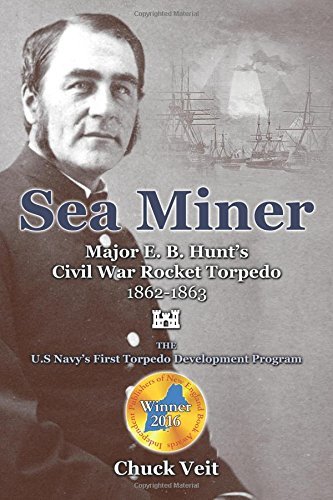Sea Miner: Major E.B. Hunt’s Civil War Rocket Torpedo, 1862-1863
Chuck Veit
 In the realm of Civil War naval history, academic writers have generally focused on big picture topics such as biographies of naval officers and general histories, for example, James McPherson’s War on the Waters and Craig Symonds’ The Civil War at Sea. However, if one digs deeper there has been much good work done on the fringes of naval warfare by either public historians or subject matter enthusiasts. Examples abound, from the histories of torpedo warfare by Milton Perry, W. Davis Waters, and Mike Kochan, to Mark Ragan’s research on Civil War submarine warfare. Much of this fine work, including the book under review here, is self-published. While that may make it more difficult to find, the search can be well worth the effort.
In the realm of Civil War naval history, academic writers have generally focused on big picture topics such as biographies of naval officers and general histories, for example, James McPherson’s War on the Waters and Craig Symonds’ The Civil War at Sea. However, if one digs deeper there has been much good work done on the fringes of naval warfare by either public historians or subject matter enthusiasts. Examples abound, from the histories of torpedo warfare by Milton Perry, W. Davis Waters, and Mike Kochan, to Mark Ragan’s research on Civil War submarine warfare. Much of this fine work, including the book under review here, is self-published. While that may make it more difficult to find, the search can be well worth the effort.
Chuck Veit’s Sea Miner: Major E.B. Hunt’s Civil War Rocket Torpedo, 1862-1863 is a fine example of excellent work being done in Civil War naval history. Veit is no stranger to unique and different topics, having published numerous books about Civil War history and having been keenly interested in the hunt for USS Alligator, the Union Navy’s little-known submarine. He is also a long-time living historian and President of the Navy & Marine Living History Association.
In Sea Miner, Veit brings to light a little-known and long-forgotten piece of naval history, the Union attempts to design and build a self-propelled underwater torpedo. Due to the paucity of resources—Major Hunt destroyed much of his own documentation to maintain secrecy—Veit admits that some of this story relies on speculation, conjecture, or just plain educated guessing. However, he has pieced together enough documentary evidence to produce a solid history of this project. The research is impressive; the amount of primary source material used is laudable considering how much must have been destroyed.
Not only does Veit show a strong grasp of the history of this project, he is able to convey the scientific and mathematical complexity of it without getting too bogged down. In fact, Chapter XI is the only chapter that reads more scientific than historical. Throughout the course of the book, Veit covers all the bases. He gives a solid biographical account of Hunt’s life, details previous efforts to design and build such weapons systems, gives a good overview of the Brooklyn Navy Yard where the project was housed, and conveys as full an accounting as possible of the Sea Miner project. He highlights the interplay and cooperation between the Army and Navy, as Hunt was on assignment from the Army to work on this project.
What emerges is not simply a history of the Sea Miner project, but a book that underscores the brilliant scientific mind of Hunt. The story is primary, while many of the scientific details are left to the appendices; this allows the story to flow without becoming overly technical. Veit does allow his regional bias to show, never using the term “Civil War” outside of the book’s title. He prefers the official period designation “War of the Rebellion,” but on occasions throughout the text uses “Slaveholder’s Rebellion” and “Slaveholder’s Revolt” as well. That might not endear him to diehard Confederate apologists, but it does not detract from his excellent work.
- Lulu.com, 2016
- 6” x 9”, softcover, 216 pages
- Photographs, appendices, diagrams, notes, bibliography, index. $17.00
- ISBN: 9781329736382
Reviewed by Andrew Duppstadt, North Carolina State Historic Sites
